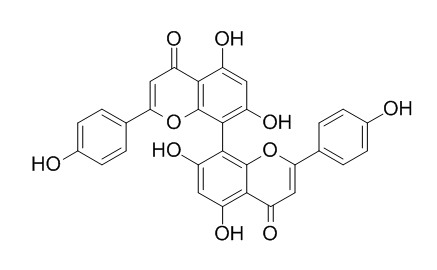Cupressuflavone
Cupressuflavone has hepatoprotective, analgesic and anti‐inflammatory effects. Cupressuflavone could exert a beneficial effect against oxidative stress by enhancing the antioxidant defense status, reducing lipid peroxidation, and protecting against the pathological changes induced by CCl4 in the liver and kidney tissues.
Inquire / Order:
manager@chemfaces.com
Technical Inquiries:
service@chemfaces.com
Tel:
+86-27-84237783
Fax:
+86-27-84254680
Address:
1 Building, No. 83, CheCheng Rd., Wuhan Economic and Technological Development Zone, Wuhan, Hubei 430056, PRC
Providing storage is as stated on the product vial and the vial is kept tightly sealed, the product can be stored for up to
24 months(2-8C).
Wherever possible, you should prepare and use solutions on the same day. However, if you need to make up stock solutions in advance, we recommend that you store the solution as aliquots in tightly sealed vials at -20C. Generally, these will be useable for up to two weeks. Before use, and prior to opening the vial we recommend that you allow your product to equilibrate to room temperature for at least 1 hour.
Need more advice on solubility, usage and handling? Please email to: service@chemfaces.com
The packaging of the product may have turned upside down during transportation, resulting in the natural compounds adhering to the neck or cap of the vial. take the vial out of its packaging and gently shake to let the compounds fall to the bottom of the vial. for liquid products, centrifuge at 200-500 RPM to gather the liquid at the bottom of the vial. try to avoid loss or contamination during handling.
Int J Mol Sci.2024, 25(6):3390.
BMC Complement Altern Med.2019, 19(1):339
Russian J. Bioorganic Chemistry2024, 50:2897-2903.
World J Microbiol Biotechnol.2024, 40(9):265.
Cell Mol Biol(Noisy-le-grand)2019, 65(7):77-83
Patanjali Research Foundation2024, ssrn.4807357
Agronomy2023, 13(9), 2410.
J. ISSAAS2023, 29(2):36-51.
Brain Res Bull.2024, 218:111103.
Nutr Res Pract.2023, 17(4):670-681.
Related and Featured Products
Drug Development Research, 2018, 79.
Anti-inflammatory and analgesic activities of cupressuflavone from Cupressus macrocarpa: Impact on pro‐inflammatory mediators.[Reference:
WebLink]
Inflammation is a complex biological process that is generally occurs in response to pathological triggers. Both neurodegenerative diseases and cancer have been linked to inflammation.
METHODS AND RESULTS:
The analgesic and anti‐inflammatory effects of Cupressuflavone (CUF) isolated from Cupressus macrocarpa were examined. The analgesic effects of CUF (40, 80 and 160 mg/kg po) were assessed in the acetic acid‐induced writhing and hot plate models in mice with diclofenac sodium as the reference standard (100 mg/kg). CUF dose‐dependently inhibited the writhing response in mice by 25, 48, and 62%, at the three CUF doses with 160 mg/kg being equivalent to the diclofenac control. CUF dose‐dependently increased the hot plate model reaction time with a maximal effect after 120 min. In the carrageenan‐induced paw edema model of inflammation, CUF demonstrated anti‐inflammatory activity by inhibiting paw edema by 55, 60, and 64% at doses of 40, 80, and 160 mg/kg po, respectively. CUF also reduced the plasma pro‐inflammatory mediators PGE2 (44, 54, and 58%), TNF‐α (26, 37, and 53%), IL‐1β (19, 33, and 41%), and IL‐6 (32, 44, and 55%) at the three doses tested with the highest dose having similar effects to diclofenac sodium (100 mg/kg).
CONCLUSIONS:
This finding from this study indicates that CUF has both analgesic and anti‐inflammatory effects.
Planta Medica, 2014, 80(18):1665-1671.
Protective role of Cupressuflavone from Cupressus macrocarpa against carbon tetrachloride-induced hepato- and nephrotoxicity in mice.[Reference:
WebLink]
The hepatoprotective and nephroprotective activity of Cupressuflavone isolated from Cupressus macrocarpa was investigated against CCl4-induced toxicity in mice.
METHODS AND RESULTS:
Cupressuflavone was administered (40, 80, and 160 mg/kg/day) for five days. CCl4 was administered (0.5 mL/kg intraperitoneally) at the end of the experiment. A substantial increase (p < 0.001) in the levels of alanine aminotransferase, aspartate aminotransferase, alkaline phosphatase, lactate dehydrogenase, total bilirubin, cholesterol, creatinine, uric acid, urea, and malondialdehyde was observed in the CCl4-treated group compared to the normal control group. In contrast, a significant reduction (p < 0.001) in glutathione and superoxide dismutase contents as well as the total protein level was evident in the CCl4-intoxicated mice. Cupressuflavone pretreatment markedly inhibited the CCl4-induced increase in alanine aminotransferase, aspartate aminotransferase, alkaline phosphatase, lactate dehydrogenase, cholesterol, creatinine, uric acid, urea, and malondialdehyde levels in a dose-dependent manner (p < 0.001 at all the tested doses). In addition, a significant (p < 0.001) and dose-dependent decrease in the total bilirubin levels was evident by Cupressuflavone pretreatment (80 and 160 mg/kg/day) when compared to the CCl4-intoxicated group. Furthermore, Cupressuflavone administration significantly increased the activity of antioxidant parameters glutathione and superoxide dismutase as well as the serum protein levels (p < 0.001 at all the tested doses) in a dose-dependent manner. Histological observations confirmed the strong hepato- and nephroprotective activity.
CONCLUSIONS:
These findings suggest that Cupressuflavone could exert a beneficial effect against oxidative stress by enhancing the antioxidant defense status, reducing lipid peroxidation, and protecting against the pathological changes induced by CCl4 in the liver and kidney tissues. The structure of Cupressuflavone was identified by NMR, UV, and HRESI-MS/MS spectral data.
Pakistan Journal of Pharmaceutical Sciences, 2013, 26(5):999-1008.
Study of the hepatoprotective effect of Juniperus phoenicea constituents.[Reference:
WebLink]
Different fraction obtained from the aerial parts of Juniperus phoenicea showed significant activity as hepatoprotective when investigated against carbon tetrachloride induced liver injury.
METHODS AND RESULTS:
The hepatoprotective activity was evaluated through the quantification of biochemical parameters and confirmed using histopathology study. Phytochemical investigation of the petroleum ether, chloroform and methanol fractions utilizing different chromatographic techniques resulted in the isolation of five known diterpenoids namely: 13-epicupressic acid (1), imbricatolic acid (2), 7α-hydroxysandaracopimaric acid (3), 3β-hydroxysandaracopimaric acid (4), isopimaric acid (5), four flavonoid derivatives: Cupressuflavone (6), hinokiflavone (7), hypolaetin-7-O-β-xylopyranoside (9), (-) catechin (10), inaddition to sucrose (8).
CONCLUSIONS:
Both physical and spectral data were used for structure determination and all isolates were evaluated for their hepatoprotective activity. Compounds 2 and 6 were effective, however; 7 was the most active. Hepatoprotective activity of 7 is comparable with the standard drug silymarin in reducing the elevated liver enzymes and restoring normal appearance of hepatocytes. Hepatoprotective effect of combination of 6, 7 and silymarin with the diterpene sugiol was also explored.



